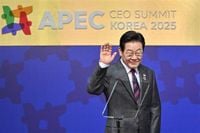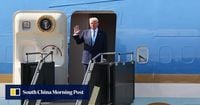The quiet, historic city of Gyeongju, South Korea, found itself thrust into the global spotlight on October 30 and 31, 2025, as it played host to the Asia-Pacific Economic Cooperation (APEC) forum. With the world’s attention focused on the southeastern city, a whirlwind of high-stakes diplomacy unfolded, featuring some of the most powerful leaders in the Asia-Pacific region. The gathering brought together South Korean President Lee Jae Myung, U.S. President Donald Trump, Chinese President Xi Jinping, and Japanese Prime Minister Sanae Takaichi—each with their own agendas, ambitions, and, naturally, a fair share of drama.
For President Lee, who took office just a few months prior in June, the summit was both an opportunity and a test. According to Nikkei Asia, Lee was in the spotlight as he welcomed his counterparts, with the world watching closely how the new leader would steer his nation through a maze of economic and security challenges. The stakes were high: trade, security, and the perennial issue of peace on the Korean Peninsula all hung in the balance.
The diplomatic marathon kicked off with a bang. On October 29, Lee hosted an APEC dinner in honor of President Trump and other state leaders. The guest list was a who’s who of regional power: Singapore’s Lawrence Wong, Thailand’s Anutin Charnvirakul, and Australia’s Anthony Albanese, among others. The menu? A fusion of modern and traditional Korean cuisine, including Gyeongju’s famous hwangnam bread and savory seaweed chips. As Nikkei Asia reported, food was just one front in South Korea’s soft power showcase, with global stars like BTS leader Kim Namjoon (RM) taking the stage at the APEC CEO Summit to champion the importance of culture in tomorrow’s investments. “When you think about investing in tomorrow’s generations, think about culture as well as economics,” RM urged, calling culture and art a “powerful force.”
But beneath the celebratory veneer, the real work was happening behind closed doors. On October 29, the top diplomats of South Korea, the United States, and Japan met for trilateral talks on the margins of the forum. South Korean Foreign Minister Cho Hyun, U.S. Secretary of State Marco Rubio, and Japanese Foreign Minister Toshimitsu Motegi reaffirmed their shared principle of denuclearizing the Korean Peninsula. The meeting, as reported by Yonhap, was their first since Motegi took office with Prime Minister Takaichi’s new cabinet. The trio agreed to “maintain close coordination on North Korea, while upholding the shared principle of denuclearization of the Korean Peninsula,” and expressed a commitment to continued cooperation for regional prosperity.
That same day, President Lee and Trump clinched a landmark trade deal—one that would reverberate well beyond the summit’s closing ceremony. The agreement, finalized on October 29, saw South Korea pledge a staggering $350 billion in U.S. investment in exchange for lower tariffs. Of that, $200 billion would be delivered as annualized cash payments, with the remaining $150 billion earmarked for shipbuilding projects. South Korea, already a shipbuilding powerhouse, would see some of these new vessels constructed at a shipyard in Philadelphia, a move designed to revive the American sector—a key priority for Trump.
President Lee couldn’t contain his enthusiasm. In a post on X, he declared, “What a great and beautiful deal! Together, we were able to reaffirm the true value of the alliance built on long-standing friendship and cooperation.” Trump, for his part, echoed the sentiment, describing his time in South Korea as “A great trip, with a great President of South Korea!”
Yet, even as leaders toasted their successes, not everyone was celebrating. The U.S. had raised tariffs on imported South Korean steel to 50% back in June, a move that sent shockwaves through Korea’s steel industry. Mayor Lee Kang-deok of Pohang, the heart of South Korea’s steel sector, told Nikkei Asia that the tariffs were “way too high,” warning that “our whole steel industry is facing a risk of collapse.” The mayor and his city government had even protested outside the White House in September, desperate to highlight the interconnectedness of the U.S.-Korea supply chain.
The diplomatic highlight of the summit came on October 30, when Trump and Xi Jinping met in Busan for a one hour and forty-minute summit. The encounter, closely watched by media worldwide, was a study in both pageantry and pragmatism. At the outset, Xi told Trump, “I always believe that China’s development goes hand in hand with your vision to make America great again.” According to Chinese state broadcaster CCTV, the two leaders discussed a range of thorny issues: trade, rare-earth minerals, TikTok, and Taiwan. Trump, ever the dealmaker, had earlier told reporters, “President Xi of China is coming tomorrow here and we’re going to be, I hope, making a deal. I think it’ll be a good deal for both. And that’s really a great result, you know, that’s better than fighting and going through all sorts of problems.”
But Trump wasn’t content to let the summit pass without making headlines. Just before his meeting with Xi, he took to Truth Social to announce plans to start testing nuclear weapons, stating, “The United States has more Nuclear Weapons than any other country. This was accomplished, including a complete update and renovation of existing weapons, during my First Term in office. Because of other countries testing programs, I have instructed the Department of War to start testing our Nuclear Weapons on an equal basis. That process will begin immediately.” The announcement sent ripples through diplomatic circles, raising fresh questions about nuclear stability in the region.
Trump also made waves by permitting South Korea to build nuclear-powered submarines, a significant departure from previous defense arrangements between the two countries. The submarines, he said, would be built at a U.S. shipyard in Philadelphia. This move, tied to the broader trade deal, signaled a new era of military and industrial cooperation between the allies.
Throughout the summit, the specter of North Korea loomed large. While Trump had previously expressed interest in meeting North Korean leader Kim Jong Un during his Asia tour, he ultimately suggested that such a meeting was unlikely to happen this time. “We really weren’t able to work out timing,” Trump told South Korea’s Yonhap news agency. Still, he left the door open, saying, “If he’d like to meet, I’m around. I’ll be in South Korea, so I can be right over there.”
Meanwhile, the trilateral talks between South Korea, the U.S., and Japan reinforced the commitment to denuclearization and regional stability. The diplomats agreed to “continue efforts to promote peace and stability through dialogue and diplomacy,” as Yonhap reported, and to maintain close communication through various multilateral meetings going forward. Foreign Minister Cho also proposed working together to enhance resilience in regional supply chains and address transnational challenges in the Indo-Pacific region.
As the summit drew to a close, President Lee presented Trump with a replica of a 6th-century golden crown—a symbolic gesture of friendship and shared history. Outside the venues, a small group of protesters voiced their opposition to APEC and Trump’s attendance, a reminder that not all South Koreans were on board with the proceedings.
For Gyeongju and the Asia-Pacific region, the 2025 APEC forum was a whirlwind of diplomacy, dealmaking, and cultural exchange. The agreements reached and the conversations begun will shape the region’s economic and security landscape for years to come.

